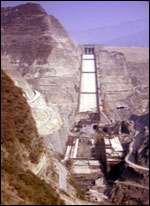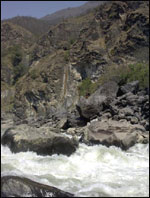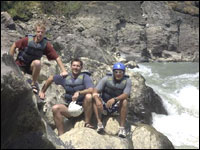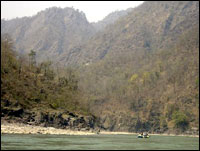Except for the occasional palm or banana tree, the Himalayan canyon walls look like those carved by the Salmon River in Idaho: The hillsides are brown and dotted with pine groves, and the boulder-strewn banks of the river give way to stretches of white sand. But this is the Bhagirathi River, half a world away from the Rocky Mountains, and I am on what is billed as the last expedition on this stretch of one of north India’s holiest waterways, before it is permanently altered by completion of the controversial Tehri Dam.

Dam site for sore eyes.
Photo: Dan Oko.
Framed by the hulking Himalayas, some 200 miles north of New Delhi, the Tehri Dam stands 855 feet high, making it the fifth-tallest dam in the world — a dubious distinction in this earthquake-prone region. The $1.2 billion hydroelectric project got underway in 1978 and has been the subject of numerous lawsuits, demonstrations, and hunger strikes, none of them successful. When the monsoon reaches north India this summer, the rains will help fill the enormous reservoir where more than 100 villages once stood. One of dozens of controversial hydro projects in India, the Tehri Dam promises to produce power and provide drinking water and irrigation supplies — but at an unknown, and worrisome, social and environmental cost.
Lately, the government of India has been promoting a so-called Garland of Rivers, a multinational river-linking project that would connect 37 major rivers through a series of dams and canals spanning the subcontinent. The project is intended to offset devastating regional cycles of drought and flood, provide rural and urban populations with stable supplies of drinking water, and harness some 34,000 megawatts of hydroelectricity. The scope of the Garland of Rivers, which calls for cooperation from neighboring Bangladesh, Nepal, and Bhutan, is unparalleled in Asia; not even China’s notorious Three Gorges Dam comes close.
In order to understand India’s predilection for dam building on such a staggering scale, you have to grasp the almost equally staggering rise in demand for water from agricultural, residential, commericial, and industrial sources in this developing nation of a billion-plus souls. Nobody knows exact figures, but groundwater supplies, which provide nearly 90 percent of rural drinking water and more than half of the drinking water for India’s major cities, are declining, and industrial pollution has contaminated major rivers such as the Yamuna and Ganges. Meanwhile, the population booms and urban development continues apace. Drought is a major regional concern, and dams such as the Tehri are seen as both a safety net and a down payment on India’s industrial promise. When complete, the Tehri project alone will provide 270 million gallons of drinking water per day, irrigation for thousands of acres of farmland, and 2,000 megawatts of electricity across the region.
Even as the reservoir behind the Tehri Dam fills, however, resettlement of nearly 100,000 villagers upstream remains a topic in India’s daily papers. Questions likewise persist about the project’s safety in this shaky geological zone, where earthquakes and landslides are commonplace.
Activist Himanshu Thakkar of the South Asia Network on Dams, Rivers, and People acknowledges that India needs to solve its water problems, but he maintains that the issue is resource mismanagement. Large-scale dams and river-linking plans, he says, simply compound difficulties surrounding pollution, deforestation, and wildlife conservation. “Until we have a full evaluation of local water sufficiency,” Thakkar says, “we do not think there is any justification for undertaking these other projects.”

Rapid descent.
Photo: Dan Oko.
Back in the Paddle
The 20 paddlers who have joined me on the Bhagirathi — most of them American expatriates — are only mildly concerned about the environmental impact of the Tehri Dam. In fact, many know nothing about the status of the river. Nevertheless, our first glimpse of the dam site prompts a hush that outlasts any silence brought on by whitewater anticipation over the next three days. In the distance, bulldozers and dump trucks look like mutant insects scuttling across the dust bowl that has replaced the town of Tehri. Across thousands of acres, the lone reminder of the communities that once occupied the area is a single Hindu temple that it seemed no one was willing to tear down.
As we chase the river through slot canyons where hydraulic forces have sculpted huge cave-pocked cliffs, our guides point out where awe-inspiring, boat-flipping waves have been replaced by small technical rapids that require barrel-race type maneuvers rather than the sheer power of strong paddlers. “We’ve never seen it this low,” says our boat captain, Dheuv Rana, who grew up in a village downstream and blames the dam authorities for spoiling rafting on the Bhagirathi.
Nonetheless, close to our trip’s halfway mark, positive energy begins to percolate. On the morning of the second day, the Bhagirathi joins with the Alakananda River flowing from the east and officially becomes the Ganges, India’s most famous and sacred waterway. As we come to the convergence, a series of large waves makes us dig in with our paddles. When the whitewater subsides, I notice increasing signs of settlement on the banks above. Heavy ropes drop into the water, where they attach to primitive nets used to catch thick-bodied carp called mahaseer. From the shore, villagers cheer us on.

Happy rafters.
Photo: Dan Oko.
All smiles, we hit two more sets of waves and a pair of paddlers fall out of the boat trailing ours, splashing merrily. It’s an auspicious place to take an accidental swim, we learn. Hindu people view the natural linking of two rivers such as the confluence of the Alakananda and Bhagirathi as a potent place to wash away sins — and all the more so at the headwaters of the holy Ganges.
The rivers meet at the town of Devprayag, where we find an enormous staircase, or ghat, leading down from a whitewashed temple. Worshippers bathing in the green current hold tight to a chain attached to the stairs; many stare with wonder at the predominantly pale-faced men passing in big blue rafts. We bow our heads out of respect.
Water Over the Dam
It’s hard to reconcile the spiritual significance many Indians attach to their waterways with the emphasis the nation currently places on hydroelectric development. There’s the Tehri Dam project here on the Bhagirathi. In the western state of Gujarat, there’s India’s most infamous dam, the $6 billion Narmada Valley undertaking, scheduled for completion in 2025. Hundreds of thousands of villagers have already been displaced. And if India chooses to ignore concerns over societal and environmental risks — ranging from civil strife to deforestation to mass epidemics — construction will begin on the Garland of Rivers within 12 years.

Hot dam.
Photo: Dan Oko.
Author and water-development expert Ramaswamy Iyer of the Center for Policy Research in New Delhi says that the advantages touted by proponents of huge dam projects and river linking reflect little more than wishful thinking. Iyer argues that conservation and water harvesting, or capturing rainfall, can do more to offset local difficulties than large-scale dam projects, which will embroil all of India in the problems of a few states. “If we forget for a moment the questionable calculus of supply and demand, and look at ‘security’ from the point of view of the ecological system,” he says, “we begin to realize that by building a series of large [water-resource development] projects, we may not be ensuring security but endangering it.”
This line is echoed globally by conservation-minded critics such as Patrick McCully, campaigns director for the California-based International Rivers Network, who visited Tehri in 2002. McCully says that in the Himalayas, where 14 waterways are targeted for Garland of Rivers projects, heavy sedimentation creates an obstacle for dam efficiency (dirt carried in the water interferes with the machinery), while maintenance on older dams often gets neglected in favor of new construction. Dam professionals agree with many of the IRN’s technical assessments. McCully supports water harvesting and other alternatives to dam building.
Monkey Wrench Ganges?
Just as the hydropower debate echoes across the subcontinent even after construction is well underway on dams, so too do we paddlers continue to feel the dark shadow of the Tehri Dam long after the actual structure has disappeared from view.
Still, in a quiet moment, we hear the elaborate song of the whistling thrush. While paddling, we spot four different species of kingfisher, including the pied kingfisher known as the “zebra of the air” for its black and white markings. Even at diminished levels, the river commands our attention; lest we forget the current’s power, the guides refuse to let us remove our lifejackets even in the calmest stretches.

Dead river’s float.
Photo: Dan Oko.
The third day finds us galvanized after having maneuvered through countless rapids, more than a little sunburned, and eager for more action. After two days of nearly relentless rapids, though, there’s not much whitewater left to face, so we gird ourselves for the upstream wind that blows each afternoon. The stiff breeze is not unpleasant, but it hinders our progress, and lunch is waiting. Towns and villages grow more common with each passing mile, and I’m struck by the havoc that would result should the dam fail. With the settlements upstream all but demolished, the dire warnings that the Tehri Dam is built on a dangerous fault line remain a final, if unlikely, reason that the authorities could delay filling the reservoir. Half a million or more lives could be at risk if this dam fails.
I can’t help but wonder if somewhere in India, the world’s largest democracy, the subcontinent’s answer to Ed Abbey’s Monkey Wrench Gang is waiting in the wings. A couple of days after our trip has ended, I even mention the ultimate Abbey solution — blowing up the dam — to a friend of mine deep into Eastern religion. “Nature has its own explosives, doesn’t it?” he smiles. I’m reminded that many Indians hold dear their own destructive hero: Shiva, a god central to Hinduism. He’s often called the Destroyer, and his mythological home just happens to be the Himalayas.



